Take advantage of a 20% discount on Optolong brand filters!
Promotion period: 1 September – 31 October 2025. Act now!
Take advantage of a 20% discount on Optolong brand filters!
Promotion period: 1 September – 31 October 2025. Act now!
On the morning of September 1, it is worth a look at the eastern sky: Venus is very close to the open star cluster M44, also known as Praesepe or the Beehive. The sight is already recognizable to the naked eye as a faint light spot right next to the prominent Venus. With binoculars, the stars of the cluster become clearly visible. On the evening of September 7, a real highlight awaits you: a total lunar eclipse. For Central Europe, the timing is particularly favorable, as the moon rises already eclipsed. This means you will see the moon directly on the eastern horizon in the evening. Times for Germany: The eclipse begins even before moonrise, which occurs in Germany around 7:38 PM, depending on the location. At this point, the moon is in the midst of totality and appears noticeably reddish. It reaches maximum darkness around 7:30 PM, and the total phase ends at 8:53 PM. For an unobstructed view, you should find a spot with a clear view to the east. Binoculars will show the lunar eclipse beautifully, but a telescope with a smartphone adapter is also great equipment for quickly capturing a photo. On the night of September 8th to 9th, the nearly full moon is near Saturn. Both objects are easy to find in the sky with the naked eye: the bright moon as a distinctive point and Saturn a little further away as a “star” that shines steadily. This duo can be observed particularly beautifully through binoculars. You can recognize the planet as a small, yellowish disc – its rings appear as a thickening at low magnification. For many, this is a good opportunity to take out the telescope and examine the rings more clearly. On this night, our satellite covers the Seven Sisters, including all the bright main stars of the star cluster. It begins around 10 PM: The moon approaches from the eastern direction and first covers the star Electra. Then it continues to move – from its bright side – in front of the remaining companion stars. It’s best to observe all of this from an unobstructed location with a good horizon view. In addition to the interesting and quite rare occultation, it is the first harbinger of the winter sky, as the Pleiades officially belong to the constellation Taurus. On the morning of September 19, it’s worth taking a look at the dawn sky. Venus is still the morning star and on this day is very close to the bright star Regulus in the constellation Leo. Nearby, you can also see the delicate crescent moon. Together, they create a beautiful trio in the sky. If you are an early riser, this is your opportunity to capture the moment with your camera. On September 21, Saturn is in opposition to the Sun. This means: Earth is positioned directly between the Sun and Saturn, and the ringed planet is visible all night long, reaching its greatest brightness. The special feature of the 2025 opposition: The rings are almost seen edge-on, making them hard to see and only about 2 degrees open. Even during twilight, the ringed planet rises above the eastern horizon and follows its apparent arc across the sky until dawn. On September 23, Neptune reaches its opposition and stands favorably in the sky. This distant ice giant can be seen all night and appears in the telescope as a small, bluish disk. Neptune is about magnitude 7.8, making it invisible to the naked eye. Binoculars show it as a faint point of light, but a telescope is needed for reliable identification. A star chart or app can help locate it in the constellation Aquarius. On October 2, the dwarf planet Ceres reaches its opposition to the Sun. It is visible throughout the night and is particularly close to Earth. Ceres, with a brightness of 7.6 magnitude, can easily be found with binoculars or a small telescope. Ceres moves as an inconspicuous point of light through the constellation Cetus, but it is not visible to the naked eye. However, a simple pair of binoculars separates it from the fainter stars in its vicinity. Those who track its movement from night to night will recognize the typical motion of a planet against the backdrop of fixed stars. On the evening of October 5th, the almost full moon passes by the ringed planet Saturn. Both are high in the sky and easily found with the naked eye. In a telescope, Saturn appears as a yellowish glowing disc. The narrow edge of the rings is only visible with a small aperture. Although the bright moon brightens the sky, it doesn’t matter for observing Saturn. The Draconids are a rather unknown meteor shower and reach their peak every year at the beginning of October. The name already reveals it: The meteors seem to come from the constellation Draco. This constellation is visible in the sky all night. The number of meteors varies greatly and always brings surprises. Normally, about ten meteors fall per hour, but in 2012, there were suddenly 400. What does that mean? It’s always worth taking a look at the sky, because perhaps a surprise is waiting. However, this year the moon will cause a brighter sky. In the second half of the night from October 13 to 14, the waning half moon meets the giant planet Jupiter. Both are in the constellation Gemini and are already conspicuous to the naked eye. You will see the moon as a bright half-circle and Jupiter as a shining point of light beside it. Early in the morning on October 19, the thin crescent moon is close to the bright Venus. Both can be seen well in the eastern sky. Together, they create a beautiful photographic motif. Meteor showers are a beautiful event for any enthusiastic stargazer, and the Orionids are no exception. Peaking from October 21 to 22, they promise about 25 to 30 meteors per hour. However, the number of shooting stars can vary from year to year. To catch the best view, set your alarm and look outside in the early morning hours. A must for all shooting star lovers. On the evening of November 2, the Moon is near the planet Saturn. Both shine in the southeastern horizon already at dusk. The Moon is a prominent point of orientation, and Saturn is slightly to the west of it. In November 2025, Saturn’s rings will still be in edge position as seen from Earth. They will appear so narrow that they are hardly visible. This is a unique opportunity to observe Saturn without its ring system, even though the sight will be very unusual. Additionally, there will be two Titan transits in November. On November 6 and November 22, the moon Titan will pass across the gas giant. On the night of November 9 to 10, the Moon moves past the planet Jupiter. The Moon appears as a large bright spot, and Jupiter looks like a very bright star. A pair of binoculars or a telescope reveals even more details. On Jupiter, you can see two dark bands of clouds. Next to it are its four largest moons, arranged as small bright spots evenly spaced. The Moon also shows many craters, which are particularly visible along the terminator. On the night of November 16 to 17, the Leonids reach their maximum, offering an impressive celestial event with up to 20 meteors per hour. This celestial event is a must for meteor fans. The Leonids get their name from the constellation Leo, from which they appear to originate. The origin of this meteor shower lies in the comet Tempel-Tuttle, whose particles cause the meteor showers annually. Particularly noteworthy: every 33 years, the meteor stream condenses into a real meteor shower, producing far more than 20 meteors per hour – sometimes even up to several hundred per hour. Uranus reaches its opposition. It shines with a brightness of 5.6 mag. Theoretically, you can see Uranus with the naked eye. In practice, however, it is better to use binoculars or a telescope. This way, you can clearly identify it. To find Uranus, it is best to use a star map. Through a telescope, Uranus appears as a small, clear disc. It has a slightly greenish color. On the morning of November 25th, Venus and Mercury will be close together at the southeast horizon. Both planets will be visible shortly before sunrise. Venus shines much brighter and thus helps with orientation. The observation is not easy, as it takes place very close to the horizon during dawn.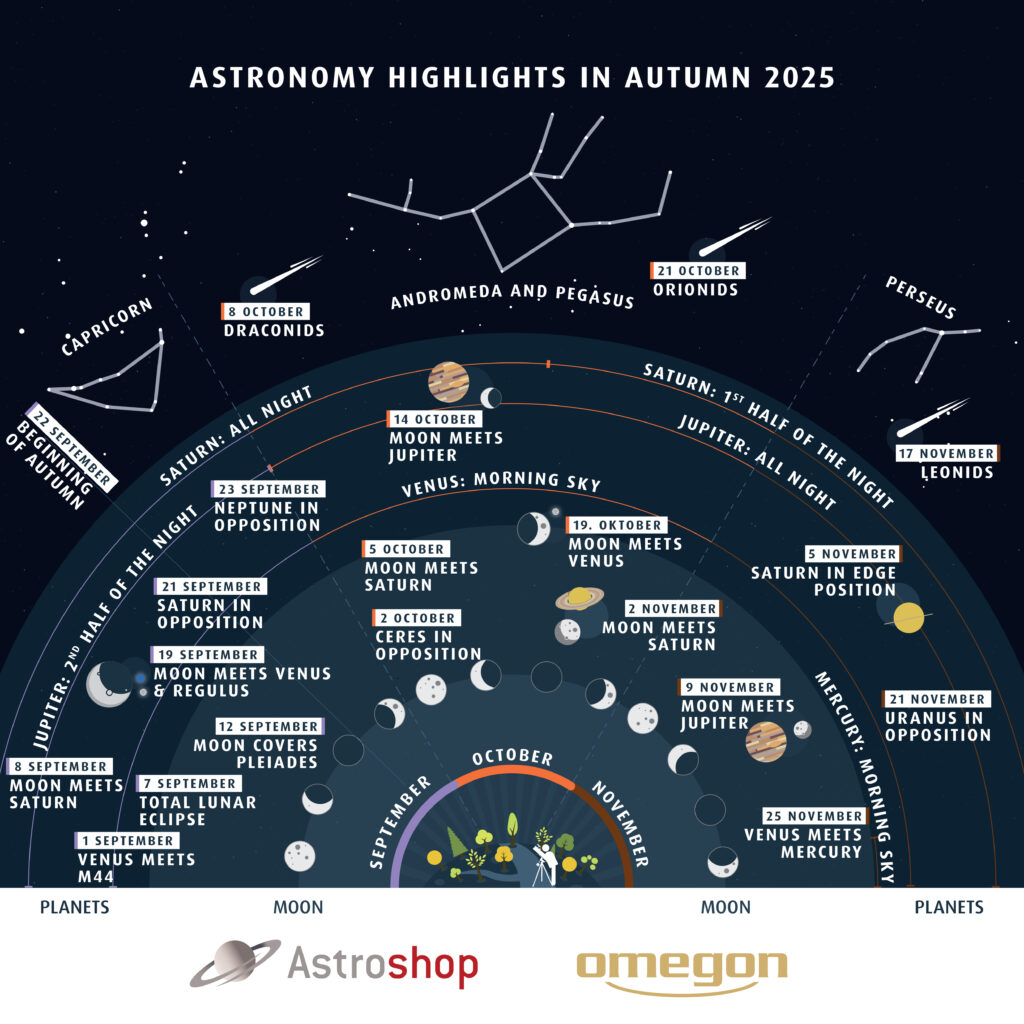
1.9. Venus meets the star cluster M44
7.9. Total Lunar Eclipse
8.9. Moon Meets Saturn
12.9. Moon covers Pleiades
19.9. Venus meets Regulus
21.9. Saturn in Opposition
23.9. Neptune in Opposition
2.10. Ceres in Opposition
5.10. Moon meets Saturn
8.10. Draconids
14.10. Moon meets Jupiter
19.10. Moon meets Venus
22.10. Orionids
2.11. Moon meets Saturn
November: Saturn in Edge Position
9.11. Moon Meets Jupiter
17.11. Leonid Meteor Shower
21.11. Uranus in Opposition
25.11. Venus meets Mercury
With the iAFS, iOptron presents the most versatile electronic focuser currently available on the market.
The big advantage: The iAFS is mounted along the optical axis and does not require any cumbersome, wobbly mounting, but is screwed firmly to the telescope.
More information about the iAFS here in the shop.
Finally, the long wait is over! On September 7, our Moon will transform into a copper-red jewel in the evening sky. The best part: this time, you don’t have to get up in the middle of the night—the eclipse begins during prime family time.
Normally, the sky has a rather nasty sense of humor. Beautiful events tend to happen at 3 a.m. This time, it’s making an exception! Starting at 7:38 p.m., the Moon will rise above the horizon as a copper ball. By then, the eclipse will already be in full swing.
6:27 p.m. – Start of the partial phase (below the horizon)
7:30 p.m. – Start of the total phase (below the horizon)
7:45 p.m. – Moonrise – now it begins
8:12 p.m. – Middle of the eclipse
8:53 p.m. – End of the total phase
9:57 p.m. – End of the partial phase
You have over an hour to enjoy this cosmic show.
During the eclipse, the Moon will be only 4° to 10° above the horizon. So choose a clear spot facing east. A hill, a meadow, or your top-floor balcony—anything where houses and trees don’t block your view.
Pro tip for photographers: The Moon’s low position is actually a gift. Your landscape shots with the red Moon will be absolutely atmospheric.
After such a long wait, you’ll surely want more than just to look. Here’s your equipment list:
Binoculars
For beginners and all-round observers: The Omegon Blackstar 2.0 8×42 binoculars bring the Moon within arm’s reach. The 8x magnification shows every crater in crisp detail. You don’t need a tripod, and you’ll still get steady images.
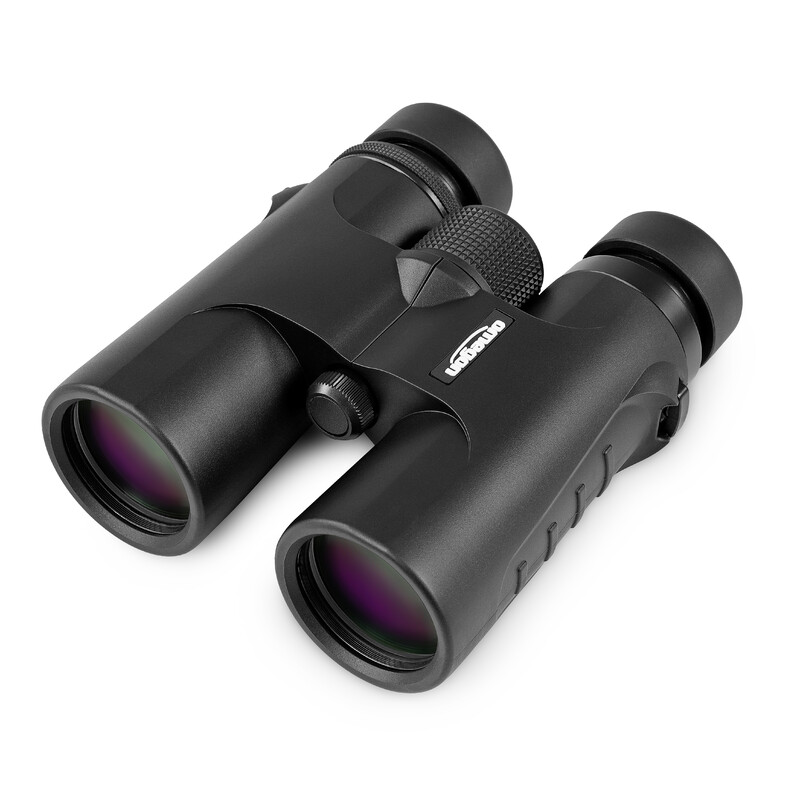
For wide-viewers: The Omegon Blackstar 2.0 10×50 brings you even more detail. With the larger aperture, you collect more light—perfect for future Milky Way trips or viewing open star clusters.
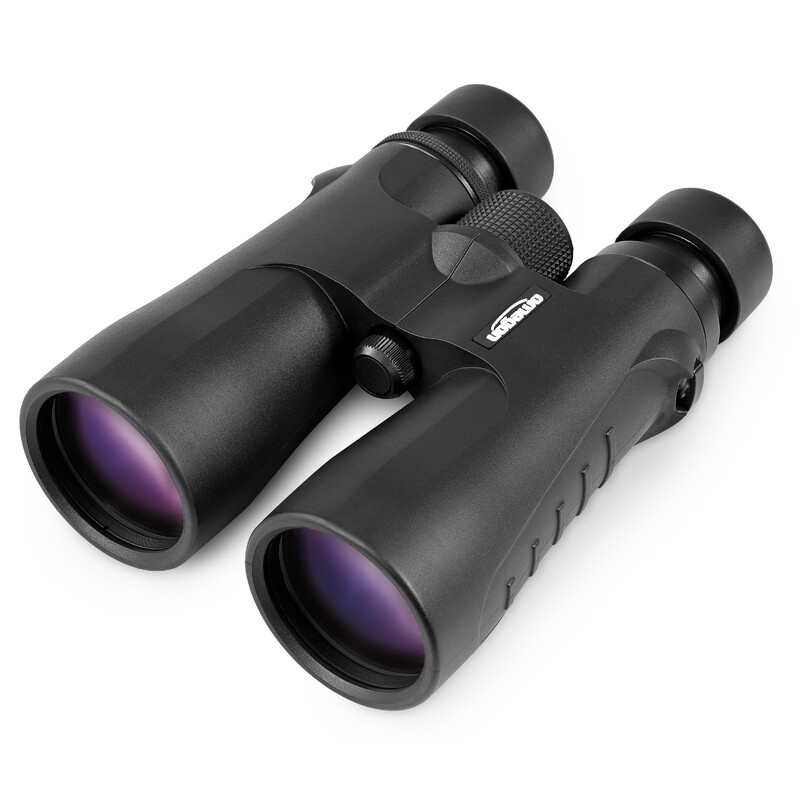
Stability boost: With the stable yet affordable Omegon Basic 250 tripod, you’ll get an even steadier image.
Telescopes
Beginners: The Omegon 90/1000 EQ-2 brings the Moon so close you’ll feel like you can touch it. The equatorial mount automatically tracks the Moon. Great fun for the whole family. The Moon and planets will become your new best friends.
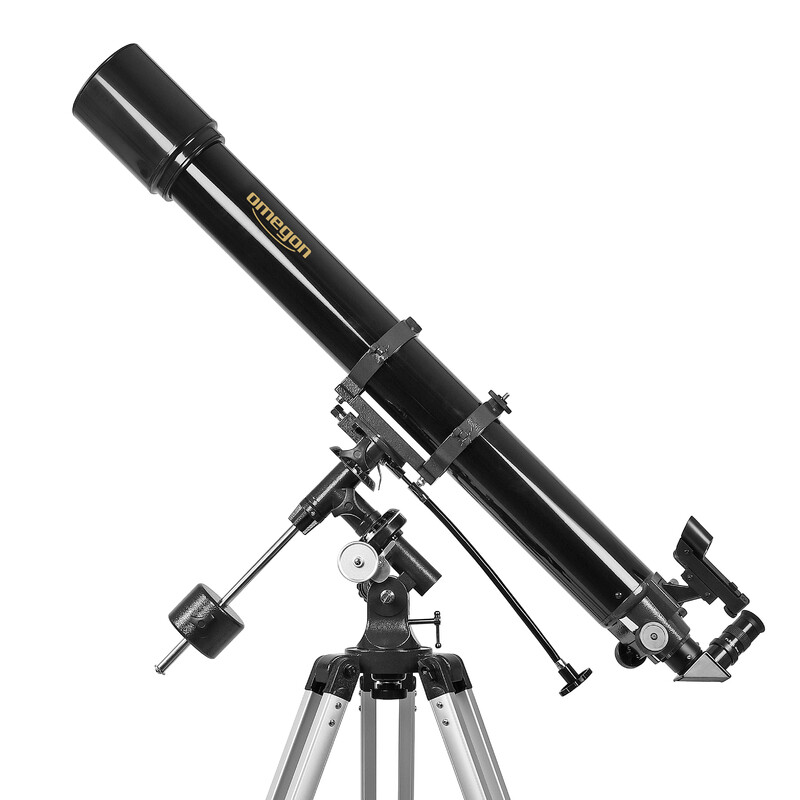
Dobson power: The Omegon Advanced X Dobson 150/1200 is your entry into the league of light-gathering telescopes. A 150 mm aperture means: the Moon, planets, and countless nebulae will be bright and clearly visible. As a new hobby astronomer, you’ll love the intuitive handling—just aim and go!
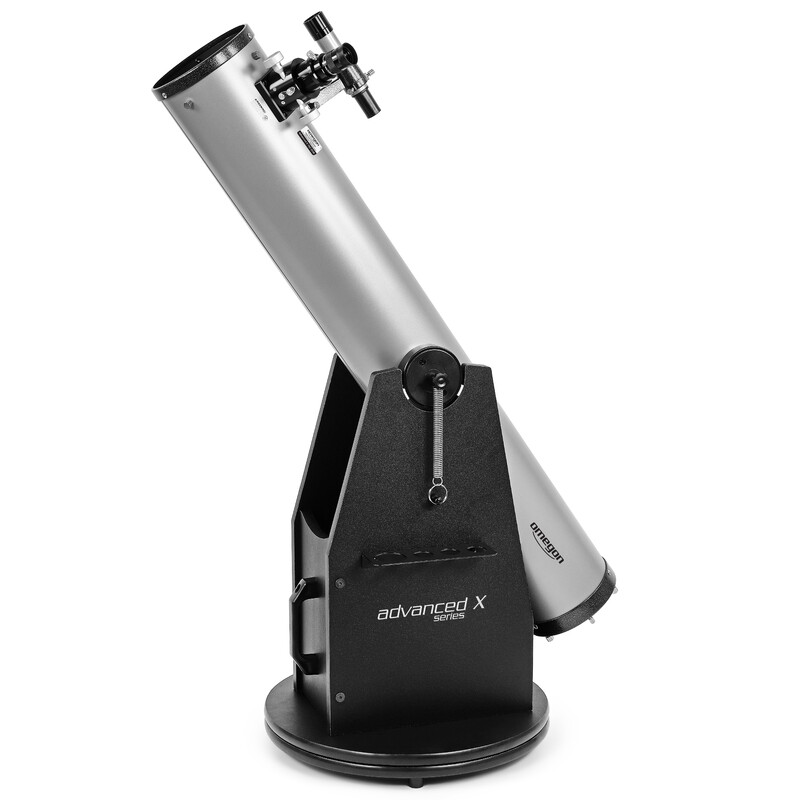
Smart telescopes
Into modern tech? Smart telescopes make astrophotography a breeze. Their apps even have special lunar eclipse modes. Perfect for tech-loving astrophotographers.
Smartphone photography
Want spontaneous snapshots directly through your telescope? The Omegon Easypic Universal Smartphone Adapter fits any 1.25″ eyepiece. Just attach your phone, focus, click, and you’re done.
For advanced users: Check out the camera adapters or special Moon and planet cameras. They’ll help you get the most out of your shots.
Not until December 31, 2028 will we once again enjoy the next total lunar eclipse. That’s more than three years of waiting! Check your equipment now.
With the HAC125DX optics, Skywatcher offers a lightweight, compact, and extremely fast telescope that will revolutionize astrophotography!
The mini astrograph is ideal for traveling to dark skies and doesn’t require a heavy mount.
Find more information here in the shop!
Bring the classroom experience home! For a short time, Levenhuk is lowering the price of the LabZZ and Rainbow 2L microscope series.
Act fast – offer valid until September 7, 2025!
At the Global Birdfair, Leica the optics specialist from Wetzlar not only presented a new spotting scope. No, two new spotting scope series, each with two objective lens diameters, were presented.
The new APO-Televid 2025 is available with 65mm and 82mm objective lens diameters. Either individually or as a set with the popular 25-50x wide-angle zoom eyepiece. The most important new feature is the improved optics with apochromatic correction and High Lux Pro (HLP) system. Proven dual focus, magnesium housing with full rubber armouring and 5m waterproofness with Aqua-Dura coating.
This revised spotting scope model is complemented by the more affordable Televid HD. Leica combines this in a set with the new 20-60x zoom eyepiece. The sacrifice of maximum quality is of course reflected in the purchase price. Leica has also introduced a range of new accessories, such as a stay-on-case. A new tripod set, which was developed in collaboration with Leofoto, and new smartphone adapters.
These are the new sets:
But it’s best to compare for yourself and get one of the first examples right away!
Vixen, the traditional Japanese manufacturer of high-quality telescopes, has introduced a new series of spotting scopes for nature observation.
The Geoma III ED series. This new spotting scope series offers high-quality ED optics and a generous scope of delivery in the medium price range.
Available in two versions and each in a set with zoom eyepiece, carrying case and smartphone adapter. Also available as a set including a high-quality aluminium tripod.
Get one now from the first delivery!
The Cat series from William Optics has enjoyed great popularity for years. The short-focus, corrected optics in Petzval design are ideal for astrophotography with small mounts.
With the Apo 108/518 UltraCat WIFD, William Optics is now launching the largest Cat to date.
You can find more information about the UltraCat telescope here in the shop.
Experience the vastness of the sky with the Omegon Panorama II Eyepiece Series. Now at a special price!
With a huge 100° field of view, these eyepieces offer an observation experience that feels almost limitless. From 21 mm (2″) to 5 mm (1.25″) focal length, the four models are perfect for deep-sky objects, wide star fields, but also for more compact objects like planets.
Get yours now. Offer valid until 30/09/2025 and only while stocks last!